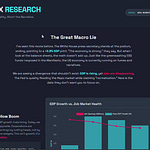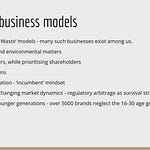In the complex tapestry of modern finance, the traditional economic models, honed over centuries, are beginning to show their seams.
For individual LPs and professional investors navigating this intricate landscape, understanding these systemic flaws isn't just academic – it's becoming a critical determinant of long-term portfolio performance and resilience.
The core challenge? Conventional economics largely operates in a vacuum, detached from the ecological realities that underpin all human activity. This is where eco-economics steps in, offering a transformative lens through which to view and manage your investments.
This isn't about mere "green investing" or ticking an ESG box; it's about a fundamental shift in perspective. Eco-economics posits that the human economy is not a perpetual motion machine, but a subsystem embedded within, and entirely dependent on, the finite biosphere. For you, the investor, this means recognizing that natural capital – clean air, fresh water, stable climate, biodiversity – is not an "externality" but the ultimate foundation of all wealth. Ignoring this truth is akin to investing in a company that dismisses its balance sheet liabilities.
The Great Disconnect: Why Traditional Metrics Fall Short
Consider the prevailing market sentiment: US equities reaching record highs, propelled by tech giants and hopes of future rate cuts. Yet, simultaneously, we observe concerning signals – contracting GDP in some developed economies, persistent inflation, and geopolitical volatility. This dichotomy reveals a profound disconnect. Traditional financial analysis, often focused on quarterly earnings, GDP growth, and interest rates in isolation, struggles to fully account for the long-term, systemic risks brewing beneath the surface.
Why does this matter to your portfolio? Because the "market" is not the "economy," and the "economy" is not the "ecosphere." When the market soars while ecological degradation accelerates, it indicates that value is being extracted, not truly created, at a sustainable rate. This short-sightedness creates hidden liabilities – future costs of climate change, resource scarcity, and social unrest – that will inevitably find their way onto corporate balance sheets and, by extension, into your investment returns.
The law of entropy, a cornerstone of eco-economics, reminds us that all economic activity consumes energy and raw materials, transforming them into waste. There is no free lunch, no infinite growth on a finite planet. Investments rooted in models of perpetual material expansion face inherent biophysical limits that traditional financial forecasting rarely incorporates. As an astute investor, recognizing this fundamental constraint allows you to identify industries and companies that are building true, sustainable value versus those merely accelerating entropy.
Reading the Market Through an Eco-Economic Lens: Current Signals
Let's apply this lens to recent market signals.
Macro-Economic Paradoxes: While inflation may show signs of easing (e.g., US core PCE dipping slightly), the underlying drivers remain complex. Geopolitical tensions, shifts in global trade policies (like the US tariff pause ending), and supply chain fragilities all contribute to price volatility that can erode returns. An eco-economic view understands these as interconnected symptoms of a global system under stress – where resource access and environmental stability play an increasingly central role.
Energy Markets: Beyond the Daily Fluctuation: Oil prices, influenced by geopolitical events like the recent Israel-Iran ceasefire, may see short-term drops. However, an eco-economic investor looks beyond the daily Brent crude price. The critical signal is the diverging investment trend: global clean energy investment is projected to be double that of fossil fuels in 2025. This isn't a mere shift; it's a structural transformation of the global energy system. Companies heavily reliant on fossil fuel extraction or high-energy-intensity production face long-term obsolescence, while those in renewables, energy efficiency, and sustainable electrification are poised for secular growth. Your portfolio’s exposure to this transition is paramount.
Corporate Dialogue: A Revealing Disconnect: Earnings calls offer a fascinating, if sometimes troubling, insight into corporate priorities. Recent data suggests a significant decline in "sustainability" mentions in Q2 2025 earnings calls, continuing a downward trend since 2021. Meanwhile, "tariffs" surged as a dominant topic. This shift indicates that immediate economic pressures are often overshadowing long-term ecological and societal considerations. For the eco-economic investor, this is a warning signal. Companies neglecting sustainability now may be accruing significant future risks, potentially facing carbon taxes, stricter regulations, supply chain disruptions due to climate impacts, or reputational damage that undermines long-term value. Conversely, companies quietly investing in sustainable practices, even if not loudly proclaiming it on earnings calls, may be building a more resilient foundation.
Navigating the Headwinds: Risks You Can’t Ignore
The transition to a sustainable economy is not without its turbulence. As an investor, you must be aware of the significant headwinds that can impact your returns:
Policy Whiplash: The regulatory landscape is a patchwork. In the US, potential federal rollbacks of environmental protections (e.g., Project 2025 proposals) contrast sharply with aggressive climate actions at the state level (California, New York, Colorado). In the EU, while the Green Deal continues, "simplification" efforts raise concerns about potential weakening. China, meanwhile, is rapidly building its own comprehensive green governance. This fragmentation creates regulatory uncertainty, increasing compliance costs and making long-term planning challenging. Your investments need to be robust enough to withstand these policy swings.
Escalating Litigation: Environmental and climate-related litigation is a growing threat. Recent US Supreme Court rulings, while complex, suggest limitations on the scope of federal environmental impact assessments (NEPA) and challenge state-level climate regulations, potentially slowing down the transition or shifting liability. Simultaneously, climate tort cases against fossil fuel companies are advancing in some state courts (e.g., Colorado), while being dismissed in others (e.g., Pennsylvania), creating a legal minefield. Furthermore, novel applications of antitrust law are now targeting asset managers for alleged collusion to reduce coal output, adding another layer of legal risk to ESG strategies. Understanding this legal flux is crucial to avoiding exposure.
Unpriced Biophysical Risk: This is perhaps the most insidious risk. The market, by and large, still does not adequately price in the true cost of resource depletion, biodiversity loss, or climate impacts. Companies operating with high water footprints in drought-prone regions, or those reliant on fragile ecosystems, carry unbooked liabilities that can suddenly materialize as supply chain disruptions, operational shutdowns, or regulatory penalties. Your portfolio needs to actively assess and minimize exposure to these unpriced, yet inevitable, costs.
Seizing the Opportunities: Investing in a Regenerative Future
For the discerning investor, these headwinds are not just risks; they are also powerful drivers of new opportunities. Applying an eco-economic lens allows you to identify where true, long-term value is being created in alignment with ecological realities.
Natural Capital Stewards: Look for companies that actively protect, restore, and value natural capital. This includes businesses in sustainable agriculture that enhance soil health and water retention, firms providing advanced water management solutions, and even those involved in large-scale ecosystem restoration projects. These companies are building resilience, reducing future liabilities, and securing essential inputs for their operations. They are effectively "capitalizing" on the very assets traditional economics often ignores.
Clean Energy & Electrification Pioneers: The shift away from fossil fuels is unstoppable. Beyond utility-scale solar and wind, consider investments in energy storage (batteries, hydrogen), smart grid infrastructure, electric vehicle charging networks, and companies developing innovative materials for a decarbonized future. Even as oil prices fluctuate, the structural demand for clean energy solutions will continue its exponential growth trajectory. FuelCell Energy's recent Q2 2025 results, for example, show significant backlog growth and revenue increases, signaling potential in this high-reward, high-risk space.
Circular Economy & Resource Efficiency Innovators: The entropy law dictates the need for radically more efficient resource use. Invest in companies that embrace circular economy principles: designing products for longevity, repair, and recycling; using recycled content; developing advanced waste-to-value technologies; and creating service models that replace product ownership. These businesses reduce reliance on finite virgin materials, mitigate supply chain risks, and transform waste into valuable inputs.
Adaptive & Resilient Infrastructure: Climate change is already here. Investing in infrastructure that is resilient to extreme weather events, enhances water security, and supports sustainable urban development is a necessity. This includes advanced building materials, smart city technologies, and companies providing solutions for climate adaptation and disaster preparedness. These investments build physical and systemic resilience, protecting communities and economic activity from escalating climate impacts.
The Investor's Fiduciary Duty in a New Era
For individual LPs and professional investors, your fiduciary duty extends beyond quarterly returns. It increasingly encompasses the long-term sustainability of the capital you manage. Integrating eco-economic principles into your investment strategy is not just about ethical alignment; it's about shrewd risk management and capitalizing on the most profound economic transition in human history.
The declining mentions of "sustainability" in corporate earnings calls, while concerning, creates an arbitrage opportunity for those with a long-term view. While others focus on immediate pressures, you can identify and invest in companies that are quietly building the foundations for a sustainable future – those that truly understand their dependence on natural capital and are aligning their business models with ecological limits.
By embracing an eco-economic perspective, you are not just investing in individual companies; you are investing in the health and longevity of the broader system that supports all economic activity. This proactive approach will position your portfolio for resilience and superior performance in a world increasingly shaped by environmental realities. The time to transcend conventional thinking and invest in the regenerative future is now.











